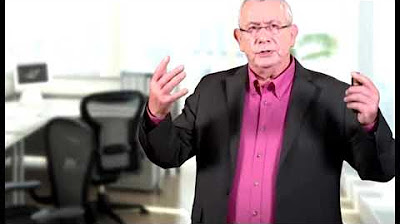Brilliant Customer Service - How to Impress your Customers! - Chapter 3
Summary
TLDRIn this chapter of 'Brilliant Customer Service,' Tony Hunt emphasizes the importance of effective communication via phone and email. He advises focusing on tone, which conveys 85% of a message, and suggests originality in script usage. For emails, he stresses professionalism, avoiding emotional responses, and maintaining a corporate identity. The chapter also covers handling difficult calls, making promises, and ensuring customer satisfaction through proper call and email etiquette.
Takeaways
- 😀 Focus on delivering 'brilliant' customer service, as it's the standard to aim for.
- 📞 Remember that 85% of the message in a phone call is conveyed through tone of voice, so train to sound enthusiastic and genuine.
- 📝 When answering the phone, use a script but personalize it to avoid sounding robotic.
- 🤔 Before answering a call, ensure your mind is focused and try to pick up within 3-4 rings.
- 🙂 Introduce yourself and ask for the caller's name to establish a personal connection.
- 🔍 Be prepared to offer action or solutions during the initial part of the call.
- 😊 Smile while on the phone, as it can be heard in your tone and makes the interaction more pleasant.
- 🔄 If you need to put a caller on hold, consider their emotional state and whether hold music might aggravate them.
- 📅 When promising to call back, under promise and over deliver to ensure customer satisfaction.
- 👤 Maintain professionalism during difficult calls, listen actively, and avoid escalating the situation.
- 📧 Email is a critical communication tool but is low on the list of preferred communication methods; use it carefully and professionally.
Q & A
What is the main theme of the video script titled 'Brilliant Customer Service'?
-The main theme of the video script is to emphasize the importance of excellent customer service, particularly focusing on effective communication through telephone and email.
What percentage of the message is said to come from the tone of voice during telephone communication?
-According to the script, 85% of the message during telephone communication comes from the tone of voice.
Why is it suggested to avoid reading a script in a repetitive manner when answering the phone?
-Reading a script repetitively can make the caller feel like they are just another call, rather than being treated with individual attention and enthusiasm.
What is the recommended approach when answering a call for the first time, even if it's the 100th call of the day?
-The recommended approach is to answer each call with enthusiasm as if it's the first call ever received, showing genuine interest in the customer.
What should be done before lifting the receiver to answer a call?
-Before lifting the receiver, one should focus their mind and be prepared to answer within three to four rings.
Why is it important to give your name when answering a call and what additional step is suggested?
-Giving your name establishes identity and trust. The additional step suggested is to ask for the caller's name and make a note of it to maintain personalization throughout the call.
What is the suggested protocol when a caller is put on hold?
-The protocol includes asking periodically if the caller is happy to wait, ensuring that the call is still owned and the caller's needs are met.
What are some alternatives to putting a caller on hold when dealing with an unhappy customer?
-Alternatives include asking if the caller is prepared to wait, directing them to voicemail, offering to call back later, providing a colleague's email for direct contact, or transferring to another person who might be able to assist.
How should one handle a situation where a customer uses inappropriate or offensive language during a call?
-One should take an assertive approach, warning the customer that the call will be ended if the inappropriate language continues, and follow through with ending the call if necessary.
What is the principle of 'under promise and over deliver' and why is it suggested in the context of making promises over the phone?
-The principle of 'under promise and over deliver' involves setting expectations lower than the actual delivery time for resolving an issue, ensuring that if the issue is resolved faster than expected, it results in a positive experience for the customer. It helps in managing customer expectations and avoiding disappointment.
Why is it advised not to express emotions such as anger in emails, especially in a professional context?
-Expressing emotions like anger in emails can lead to regret later, as the written word is permanent and can be read by unintended audiences, potentially causing embarrassment or legal issues.
What are some best practices for writing professional emails as outlined in the script?
-Best practices include using correct spelling, grammar, and punctuation, maintaining a professional tone, using a consistent corporate identity in formatting, and avoiding the expression of emotions.
Outlines

Dieser Bereich ist nur für Premium-Benutzer verfügbar. Bitte führen Sie ein Upgrade durch, um auf diesen Abschnitt zuzugreifen.
Upgrade durchführenMindmap

Dieser Bereich ist nur für Premium-Benutzer verfügbar. Bitte führen Sie ein Upgrade durch, um auf diesen Abschnitt zuzugreifen.
Upgrade durchführenKeywords

Dieser Bereich ist nur für Premium-Benutzer verfügbar. Bitte führen Sie ein Upgrade durch, um auf diesen Abschnitt zuzugreifen.
Upgrade durchführenHighlights

Dieser Bereich ist nur für Premium-Benutzer verfügbar. Bitte führen Sie ein Upgrade durch, um auf diesen Abschnitt zuzugreifen.
Upgrade durchführenTranscripts

Dieser Bereich ist nur für Premium-Benutzer verfügbar. Bitte führen Sie ein Upgrade durch, um auf diesen Abschnitt zuzugreifen.
Upgrade durchführenWeitere ähnliche Videos ansehen

Brilliant Customer Service - How to Impress your Customers! - Chapter 2

Brilliant Customer Service - How to Impress your Customers! - Chapter 5

Aula 1

Brilliant Customer Service - How to Impress your Customers! - Chapter 4

Omnichannel Customer Service - What it is, and how to deliver it

Brilliant Customer Service - How to Impress your Customers! - Chapter 1
5.0 / 5 (0 votes)
